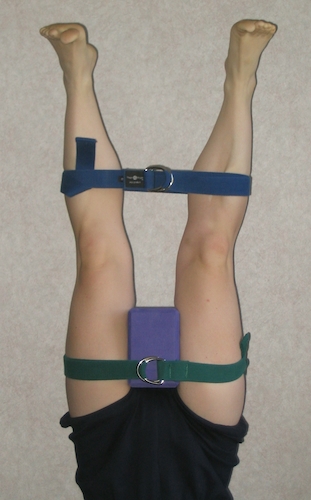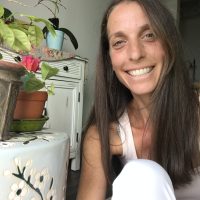Recently, I attended an Iyengar style yoga class in Manhattan.
This discipline of yoga focuses heavily on anatomical alignment (i.e., keeping the body safe and supported) and is structured more like a workshop than a free-flowing yoga class.
Like many students of yoga, I like to “flow” in my classes. Moving—mindfully, steadily, gracefully— through yoga poses, one breath at a time, has helped to clear the cobwebs of my mind. I am something of a flow junkie.
But like all things we become attached to in life there is a need, an opportunity, to find balance.
When, in the past, I inadvertently attended a yoga class with an instructor who was influenced by the Iyengar style (e.g., heavy instruction/alignment cues, props, shuffling around of yoga mats and props, moving to the wall and back) I wanted to hightail it out of there, and sometimes I did.
When I stayed, I grew tense because I was trying so hard to understand the detailed cues and to get everything right. The stop-and-go class style felt choppy and disjointed to me. It was the opposite of that light, flow-y feeling I desired.
So, I avoided these classes like the plague. And I avoided using props, not because I didn’t think I needed them but because I didn’t understand why I needed them, and having a bunch of stuff surrounding my mat felt stifling to me; yoga was about simplicity.
And then one day I decided I wanted to deepen my yoga practice, and possibly begin teaching yoga.
Enter: 200-hour YogaWorks teacher training, where on weekends, for some 12 hours, we did exactly what I had been avoiding. The entire session was, naturally, a series of stop-and-go exercises and attempting to understand alignment cues. It was a teacher training, after all, so this was to be expected but somehow it did not register in my vinyasa-loving brain that this is how it would go down.
Move my buttocks flesh where? I didn’t know I could move my buttocks flesh. And, furthermore, gross.
Lift the inner arches of my feet? Firm my outer ankles where? Huh? Come again?
And props. Props galore. Belts, blocks, blankets, bolsters, oh my!
I was tortured for a while until I slowly understood…understood that I needed to learn how to break down the poses. How could I teach someone how to do yoga if I didn’t have a clear concept of the basic components of each pose?
It began to sink in. When in Tadasana (Mountain Pose) and other standing poses, I bring awareness to my feet. By lifting my inner arches up, I begin to engage my leg muscles. If I, simultaneously, firm my outer ankles in, I balance the weight in my feet.
I will be the first to admit that these alignment cues are subtle and, if taken too far, can lead you down an obsessive road, but when you think of the weight your feet bear, the fact that they support the entire body and are the foundation of each standing pose, it begins to make sense.
If, in the same pose, I release the flesh of my buttocks (I will admit this is not my favorite cue, and not a term you will ever catch me uttering in my own class) toward my heels, I counteract any overarching in my low back. The low back is one of the most vulnerable areas in the body and it needs to be protected, supported.
We focus on the parts so we can support the whole.
And, so, over the course of my six-month Teacher Training, I came to not only respect my yoga props but to value them. I can’t remember when, precisely, the shift happened; when I went from begrudgingly retrieving blocks, blankets, strap and, god forbid, a bolster and plopping them down lethargically on my mat to feeling naked without them.
I think the shift happened gradually, but what I do remember is suddenly feeling integrated, expanded, and elated in Utthita Trikonasana (Extended Triangle Pose), a pose that had been somewhat challenging for me, probably because I had been shoving my body into a place that it was not ready to go. By sharing some of the weight of the pose with my block, by allowing the block to lift and support me, my body was granted more space, more freedom, to open and expand.
Despite this new-found freedom via my props, despite my deepening, more integrated, understanding of the asanas (yoga poses), I was and still am a person who requires fluid, connected movement in order to become centered and then, hopefully, still.
So although I entered the aforementioned two-hour Iyengar class with an open heart and mind, it was still challenging for my movement-prone self.
I listened. I fidgeted. I tensed up. I tried hard. And, at times, I let go.
We worked hard in Adho Mukha Savasana (Downward Facing Dog), harder than I have ever worked in that pose. I absorbed the instructions and felt what was happening in my body in a way I normally do not.
I tolerated, with as much grace as I could muster, the parts of class when we stopped to retrieve more props or move our mats to the wall and then back again. This stop-and-go quality doesn’t feel natural to me, but I now recognize that this pause, this moment of being taken out of rhythm, can provide clarity.
Toward the end of class, we looped a strap around our arms in Urdhva Hastasana (Upward Hand Pose). As instructed, I placed the strap around both my arms and then the back of my head, so that the bottom of my head, the occiput, was supported by the strap. It felt good to have support there since my shoulders are tight and my neck often feels strained. I could let go. As we stood, supported, in this pose our instructor, Carrie Owerko, said something that struck me: “Take support,” she encouraged. “Sometimes we need a container, a structure, in order to feel free.”
I understood in that moment, while “taking support,” that we sometimes need to accept support in life in order to grow. Doing everything on our own does not necessarily make us stronger. I thought about how I was accustomed to fending for myself in life. It was as though I would rather struggle than be supported. Or, perhaps more accurately, I was not aware, or did not trust, that support (in whatever form it took) would be there for me.
I can’t truthfully say that I enjoy this style of yoga. Not yet. Maybe not ever. But I was present, aware, throughout most of the Iyengar class that day and that is big progress.
Learning about correct alignment and using props that support my body has lead me to feel more grounded and then more expansive in my yoga poses. I am now better equipped to receive the benefits of each pose in my more “flow-y” classes. I am learning to take support in life, to branch out and connect to others rather than “going it alone.” Understanding that I am not alone, that I do not have to conquer everything on my own, has been liberating.
Love elephant and want to go steady?
Sign up for our (curated) daily and weekly newsletters!
Author: Nicole Alexander
Editor: Travis May
Photo: Wikimedia Commons













Read 1 comment and reply